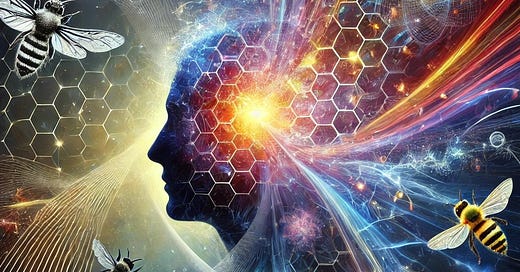The Filtered Reality: How Human Senses Shape and Limit Our Perception of the World
by Dietrick Hardwick
Our Perception Is Just a Slice of Reality
Have you ever stared at a fixed point in an image and watched as the surrounding colors faded away, like in the Troxler effect? Or perhaps, after learning a new word or idea, you suddenly noticed it popping up everywhere? These experiences reveal just how much of reality our brains are actively filtering or highlighting for us. Humans evolved with a finely tuned “headset” of senses and cognitive filters designed to help us survive, but this also means we miss out on much of the universe’s full spectrum.
Let’s explore the ways our perception is shaped, limited, and even tricked by the mechanisms of our brains and senses.
1. The Troxler Effect: Vision Beyond What We See
The Troxler effect demonstrates how focusing on a fixed point can make your brain “erase” surrounding unchanging stimuli. This is because our neurons are designed to prioritize new or moving information while tuning out what seems static and irrelevant. While useful for filtering distractions, it underscores how much our perception is built to ignore.
2. The Baader-Meinhof Phenomenon: The Frequency Illusion
Ever learned a new word and suddenly started hearing it everywhere? That’s the Baader-Meinhof phenomenon, also known as the frequency illusion. It happens because our brains prioritize recently learned information, causing it to stand out in our environment. This isn’t because the word suddenly appeared more often—it’s because your brain decided it’s relevant now.
3. Change Blindness and Inattentional Blindness
These phenomena highlight just how much we miss in plain sight. In change blindness, people fail to notice large changes in a visual scene, especially when their attention is elsewhere. Inattentional blindness occurs when we’re so focused on one task that we completely fail to notice something obvious, like a gorilla walking through a basketball game (a famous experiment). These effects demonstrate that our brains prioritize tasks over “seeing everything.”
4. The Sensory “Headset”: What We Can’t Perceive
Human senses are finely tuned to detect what helped us thrive in our evolutionary environment, but we’re blind to so much more:
• Electromagnetic Waves Beyond Visible Light: Infrared, ultraviolet, and radio waves are invisible to us, yet animals like bees and snakes can sense them.
• Magnetic Fields: Birds and turtles navigate using the Earth’s magnetic fields—humans cannot.
• Dark Matter and Dark Energy: The majority of the universe’s substance is invisible and undetectable to human senses.
• Microorganisms and Small Scales: We’re oblivious to the microscopic world around us without technology.
5. Why These Filters Exist
From an evolutionary standpoint, filtering reality wasn’t a limitation but an advantage. Processing only the most relevant stimuli allowed us to focus, survive, and act quickly. A predator hiding in the bushes mattered more than infrared light or quantum fluctuations.
However, these sensory limitations remind us that our perception of “reality” is incomplete. By using technology like telescopes, microscopes, and sensors, we’ve been able to extend our sensory “headset” to reveal more about the world—but the full picture still eludes us.
Conclusion: The Beauty of a Filtered Reality
While our senses give us an incomplete view of the universe, they also offer a curated experience optimized for our needs. Exploring how our brains work and how we can push beyond these sensory boundaries reveals a deeper appreciation for both the seen and unseen worlds.
What’s around us, even if we can’t perceive it, is a mystery worth exploring. Perhaps understanding the gaps in our perception is the first step toward truly expanding our view of reality.




